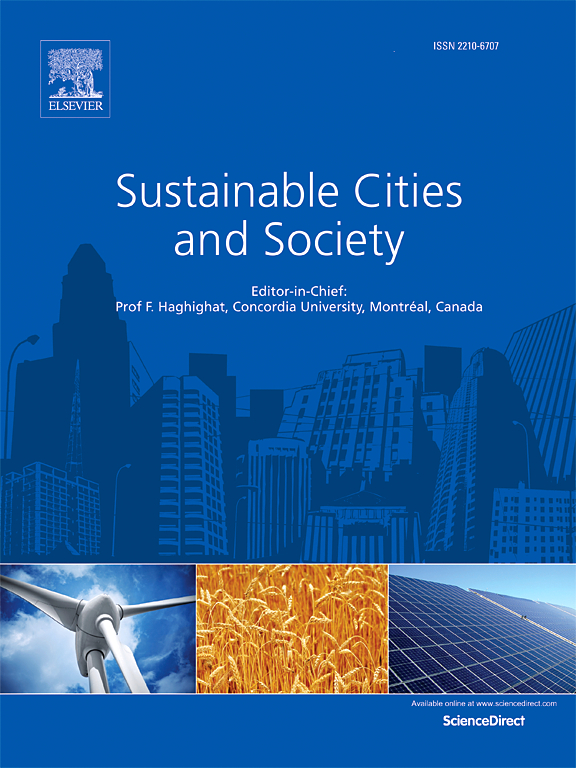Assessing a decision-support tool to estimate the cooling potential and economic savings of urban vegetation in Singapore
IF 10.5
1区 工程技术
Q1 CONSTRUCTION & BUILDING TECHNOLOGY
引用次数: 0
Abstract
To mitigate the growing threat of urban heat, cities are implementing greening strategies such as tree planting or the development of parks. Effectively integrating these solutions into planning requires quantitative information on the cooling effect of urban vegetation. Here we examined the performance of an open-source decision-support tool, the Integrated Valuation of Ecosystem Services and Tradeoffs Urban Cooling model, to estimate the cooling effect and economic benefits of urban vegetation in a tropical city context, using Singapore as an exemplar case study. Using observed temperature data, we calibrated the model to estimate the spatial distribution of annual average day- and night-time temperature at 10 m spatial resolution and validated the results using leave-one-out cross validation. The calibrated models performed well to estimate annual average daily mean and maximum (day), and minimum (night) temperatures (R2 of 0.78, 0.65, and 0.52 respectively). We estimated that urban cooling in Singapore provides economic savings of $47.14 million SGD annually from reduced energy consumption in public residential buildings, based on the relationship between energy consumption and mean temperature. Our results give confidence in the model as a decision-support tool to estimate urban heat island effects and evaluate heat mitigation strategies in tropical cities.
评估决策支持工具,以估计新加坡城市植被的冷却潜力和经济节约
为了缓解日益严重的城市热威胁,城市正在实施绿化战略,如植树或开发公园。将这些解决方案有效地整合到规划中需要关于城市植被降温效果的定量信息。在这里,我们研究了一个开源的决策支持工具的性能,生态系统服务和权衡城市降温模型的综合评估,以估计热带城市背景下城市植被的降温效果和经济效益,并以新加坡为例进行了案例研究。利用实测温度数据,对模型进行了标定,估算了10 m空间分辨率下的年平均昼夜温度的空间分布,并用留一交叉验证方法对结果进行了验证。校正后的模型在估计年平均日平均、最高(日)和最低(夜)温度方面表现良好(R2分别为0.78、0.65和0.52)。根据能耗与平均温度之间的关系,我们估计新加坡的城市制冷每年可通过减少公共住宅建筑的能耗节省4714万新元。研究结果表明,该模型可作为预测热带城市热岛效应和评估热缓解策略的决策支持工具。
本文章由计算机程序翻译,如有差异,请以英文原文为准。
求助全文
约1分钟内获得全文
求助全文
来源期刊

Sustainable Cities and Society
Social Sciences-Geography, Planning and Development
CiteScore
22.00
自引率
13.70%
发文量
810
审稿时长
27 days
期刊介绍:
Sustainable Cities and Society (SCS) is an international journal that focuses on fundamental and applied research to promote environmentally sustainable and socially resilient cities. The journal welcomes cross-cutting, multi-disciplinary research in various areas, including:
1. Smart cities and resilient environments;
2. Alternative/clean energy sources, energy distribution, distributed energy generation, and energy demand reduction/management;
3. Monitoring and improving air quality in built environment and cities (e.g., healthy built environment and air quality management);
4. Energy efficient, low/zero carbon, and green buildings/communities;
5. Climate change mitigation and adaptation in urban environments;
6. Green infrastructure and BMPs;
7. Environmental Footprint accounting and management;
8. Urban agriculture and forestry;
9. ICT, smart grid and intelligent infrastructure;
10. Urban design/planning, regulations, legislation, certification, economics, and policy;
11. Social aspects, impacts and resiliency of cities;
12. Behavior monitoring, analysis and change within urban communities;
13. Health monitoring and improvement;
14. Nexus issues related to sustainable cities and societies;
15. Smart city governance;
16. Decision Support Systems for trade-off and uncertainty analysis for improved management of cities and society;
17. Big data, machine learning, and artificial intelligence applications and case studies;
18. Critical infrastructure protection, including security, privacy, forensics, and reliability issues of cyber-physical systems.
19. Water footprint reduction and urban water distribution, harvesting, treatment, reuse and management;
20. Waste reduction and recycling;
21. Wastewater collection, treatment and recycling;
22. Smart, clean and healthy transportation systems and infrastructure;
 求助内容:
求助内容: 应助结果提醒方式:
应助结果提醒方式:


